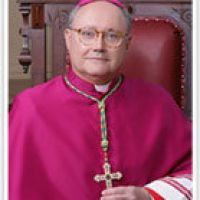Sad news here but again hopeful that he caught it early. Go see Archbishop Gregory diagnosed with prostate cancer at the the The Atlanta Journal-Constitution. It is a very good write up on what appears to be a incredible Bishop. He is not only one of the great Catholic leaders in the United States but also a important leader for African American Catholics. African Americans are a group that in my opinion are targeted enough by the American Catholic Church. Why I don't know. However, I get a sense when I go across Catholic blog land here in the USA that there are very few "Black" Catholic bloggers. It is something I just pick up when I am reading their blogs and their life stories. In fact I just know one.
Archbishop Gregory is also a fine example that this Catholic vocation shortage we hear so much about is very inflicted.The Deacon's Bench just a few days ago had an excellent piece called In Atlanta Vocations growing vocations like peaches. A very illuminating read. Also see his post Seminarians Take a Midnight Ride to Georgia. In that post we see in part:
Across the nation there is a shortage of priests, but the Archdiocese of Atlanta's 95 churches and missions have 262 priests and more than 50 seminarians in training.
Let that soak in for a moment. Really take a step back and let that soak in. This is the deep South. This is the queen City of the Protestant South. Yet they have 50 seminarians in training. Unreal!!!!
This is a Diocese of 650,000 Catholics!!! That number is not that many considering the other demographics of that region. Pretty incredible.
Since I love history and also a Civil War buff let me throw in this interesting historical nugget about this Diocese while we are on the topic
In 1861 Fr. Thomas O’Reilly, who was to become one of Atlanta ’s most well known priests, was appointed pastor of the Atlanta Catholic Church and its missions. His pastorate was to be shaped by the War Between the States. Throughout the war, Fr. O’Reilly gave aid both in the field and in makeshift hospitals to soldiers on both sides of the conflict. Because he ministered to Union soldiers as well as those of the Confederacy (of which he was an official Confederate Chaplain), he became known personally by many individual Union soldiers. Catholics in the Federal army also attended his Masses during the siege and occupation of Atlanta .
Fr. O’Reilly and Fr. Jeremiah F. O’Neill, Jr., became known for their selfless hospital ministry during the war years. They not only personally gave material and spiritual aid to the soldiers, but also encouraged parishioners to minister to patients in the many hospitals around Atlanta .
In 1864 hearing of an order to Sherman to destroy and burn the city of Atlanta, Fr. O’Reilly warned General Slocum of Sherman’s army staff that if they persisted in the plan to burn down the Catholic Church, Sherman would face massive desertions of the Catholics in the Federal ranks.(A majority of Sherman’s forces on this campaign were said to be Catholic, and many had personal knowledge or experience of Fr. O’Reilly.) During Sherman ’s burning of Atlanta , some of these Federal soldiers did help to protect the church by preventing the setting of fires too near the church building .
Fr. O’Reilly’s intercessions with Sherman ’s staff also apparently saved the Court House, City Hall, and several other churches including St. Philip’s Episcopal Church, Trinity Methodist, Second Baptist, and Central Presbyterian. All were saved from destruction, although most were occupied for various uses by the Union soldiers.
The Atlanta Catholic Church was not burned, but it was damaged by shells that exploded in the vicinity. The Northern army occupied the church building and for a time used it as a supplemental hospital.
When the citizens of Atlanta who had fled during the siege returned at the war’s end, they found their city almost totally destroyed by fire. The “spared” churches, including the Catholic church building, became places of refuge to temporarily house the homeless returnees.
Tuesday, October 30, 2007
Major American Catholic Leader Fighting Cancer-Archbishop Gregory of Atlanta(Vocation Bishop)
Posted by
James H
at
10/30/2007 10:48:00 AM
![]()
Labels: Catholic, United State Catholics, United States Catholic History, vocations
Subscribe to:
Post Comments (Atom)















No comments:
Post a Comment